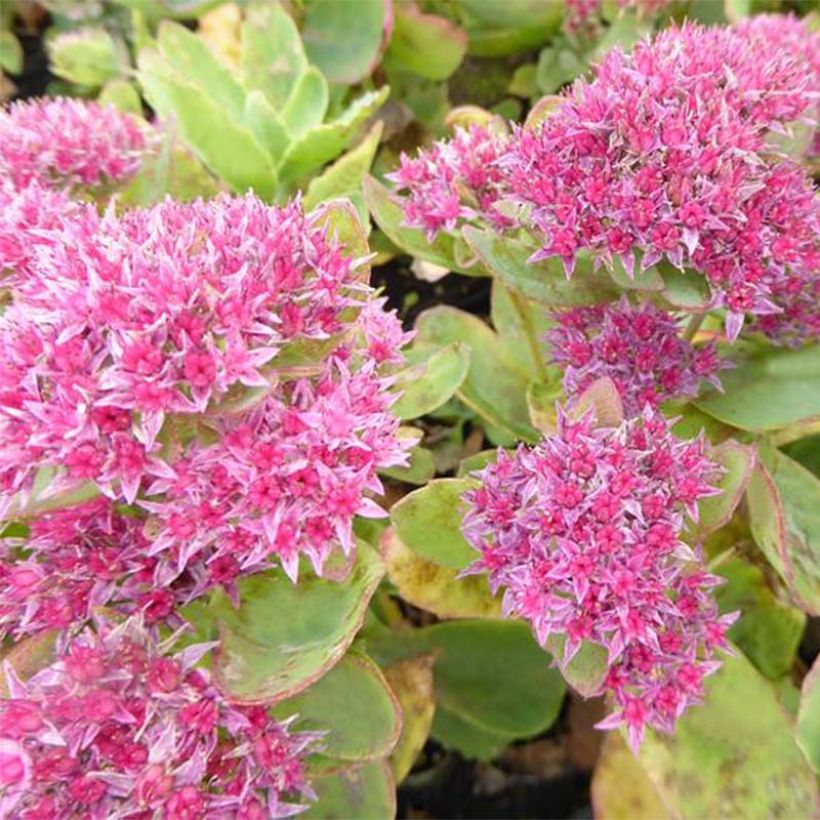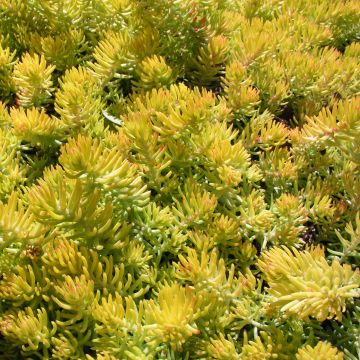

Sedum Tropical Night - Orpin d'automne.
Sedum spectabile Tropical Night - Autumn Stonecrop
Sedum x spectabile Tropical Night
Autumn Stonecrop
Special offer!
Receive a €20 voucher for any order over €90 (excluding delivery costs, credit notes, and plastic-free options)!
1- Add your favorite plants to your cart.
2- Once you have reached €90, confirm your order (you can even choose the delivery date!).
3- As soon as your order is shipped, you will receive an email containing your voucher code, valid for 3 months (90 days).
Your voucher is unique and can only be used once, for any order with a minimum value of €20, excluding delivery costs.
Can be combined with other current offers, non-divisible and non-refundable.
Why not try an alternative variety in stock?
View all →This plant carries a 12 months recovery warranty
More information
We guarantee the quality of our plants for a full growing cycle, and will replace at our expense any plant that fails to recover under normal climatic and planting conditions.
Would this plant suit my garden?
Set up your Plantfit profile →
Description
Sedum 'Tropical Night' is a new variety of autumn stonecrop that resembles the famous S. matrona, while offering a more vibrant flowering. It is a succulent and fleshy plant with sturdy stems that blooms in late summer, in the form of large, rounded, red-pink inflorescences where butterflies gather. The flowering period is long and is followed by the formation of decorative seeds that persist in winter. It is a truly rewarding plant. It is carefree and requires very little maintenance. It adds a lot of charm to the late season. It thrives even in dry and shallow soil.
The 'Tropical Night' autumn stonecrop belongs to the Crassulaceae family. It is one of the many cultivars derived from Sedum spectabile, a succulent plant with fleshy roots native to low-altitude mountains in China and Korea. It forms bushy and upright tufts, with a slightly spreading habit reaching 40cm (16in) in all directions. Its growth rate is quite slow. The flowering occurs sometimes as early as the end of August, most often in September, and ceases with the first frost. The inflorescences, in flat and dense terminal cymes, reach 10 to 12cm (4 to 5in) in diameter. They are carried by violet stems. The very small star-shaped flowers are born in intense coral red buds, then open in a pink-red hue before fading into a softer shade. They make up false umbels which are intensely nectar-rich and honey-bearing. The thick and fleshy deciduous foliage is glossy. It bears a tender green colour tinged with purple-violet, which makes a beautiful setting for the flowering. The leaves measure 8cm (3in) long. They are flat and ovate, with dentate margins on the upper half. The decorative seeds serve as food for birds in winter.
Sedum 'Tropical Night' is a boon for gardens with lean soil. It tolerates drought and rocky soils. It appreciates dry winters, even cold ones, while a lack of water in summer does not prevent it from flowering. Plant it with compact grasses (stipa, carex) and plants with grey foliage (wormwoods, senecio, stachys, lavender) that accept the same difficult living conditions. You can create a unique scene by planting it with asters, Verbena 'Buenos Aires', echinaceas, or fuchsias. Its sculptural appearance is magnificent in a pot. Its flowers are also excellent for drying or for fresh bouquets.
Sedum spectabile Tropical Night - Autumn Stonecrop in pictures




Flowering
Foliage
Plant habit
Botanical data
Sedum
x spectabile
Tropical Night
Crassulaceae
Autumn Stonecrop
Cultivar or hybrid
Other Sedum
View all →Planting and care
Plant Sedum 'Tropical Night' in ordinary, rich, dry and limestone soil. It must be well-drained to protect the roots from the cold moisture of winter. It tolerates clay soils in regions with dry winters. Excessive fertilisation can distort this upright variety. Plant it in full sun to enhance the foliage colouration. This plant is hardy once established. It needs some moisture during its growing period. In pots, provide a layer of gravel for drainage. Cut back the clump in winter when it is dry. Divide the plant after 3 to 4 years to encourage vigorous growth and prevent it from thinning out in the centre and the lateral stems from collapsing onto the ground.
Stonecrops are very easy to propagate. In spring, cut a stem or even a leaf and leave for a few days in a dry and shaded place, before placing in a tray of moist sand.
Planting period
Intended location
Care
Planting & care advice
This item has not been reviewed yet - be the first to leave a review about it.
Similar products
Haven't found what you were looking for?
Hardiness is the lowest winter temperature a plant can endure without suffering serious damage or even dying. However, hardiness is affected by location (a sheltered area, such as a patio), protection (winter cover) and soil type (hardiness is improved by well-drained soil).

Photo Sharing Terms & Conditions
In order to encourage gardeners to interact and share their experiences, Promesse de fleurs offers various media enabling content to be uploaded onto its Site - in particular via the ‘Photo sharing’ module.
The User agrees to refrain from:
- Posting any content that is illegal, prejudicial, insulting, racist, inciteful to hatred, revisionist, contrary to public decency, that infringes on privacy or on the privacy rights of third parties, in particular the publicity rights of persons and goods, intellectual property rights, or the right to privacy.
- Submitting content on behalf of a third party;
- Impersonate the identity of a third party and/or publish any personal information about a third party;
In general, the User undertakes to refrain from any unethical behaviour.
All Content (in particular text, comments, files, images, photos, videos, creative works, etc.), which may be subject to property or intellectual property rights, image or other private rights, shall remain the property of the User, subject to the limited rights granted by the terms of the licence granted by Promesse de fleurs as stated below. Users are at liberty to publish or not to publish such Content on the Site, notably via the ‘Photo Sharing’ facility, and accept that this Content shall be made public and freely accessible, notably on the Internet.
Users further acknowledge, undertake to have ,and guarantee that they hold all necessary rights and permissions to publish such material on the Site, in particular with regard to the legislation in force pertaining to any privacy, property, intellectual property, image, or contractual rights, or rights of any other nature. By publishing such Content on the Site, Users acknowledge accepting full liability as publishers of the Content within the meaning of the law, and grant Promesse de fleurs, free of charge, an inclusive, worldwide licence for the said Content for the entire duration of its publication, including all reproduction, representation, up/downloading, displaying, performing, transmission, and storage rights.
Users also grant permission for their name to be linked to the Content and accept that this link may not always be made available.
By engaging in posting material, Users consent to their Content becoming automatically accessible on the Internet, in particular on other sites and/or blogs and/or web pages of the Promesse de fleurs site, including in particular social pages and the Promesse de fleurs catalogue.
Users may secure the removal of entrusted content free of charge by issuing a simple request via our contact form.
The flowering period indicated on our website applies to countries and regions located in USDA zone 8 (France, the United Kingdom, Ireland, the Netherlands, etc.)
It will vary according to where you live:
- In zones 9 to 10 (Italy, Spain, Greece, etc.), flowering will occur about 2 to 4 weeks earlier.
- In zones 6 to 7 (Germany, Poland, Slovenia, and lower mountainous regions), flowering will be delayed by 2 to 3 weeks.
- In zone 5 (Central Europe, Scandinavia), blooming will be delayed by 3 to 5 weeks.
In temperate climates, pruning of spring-flowering shrubs (forsythia, spireas, etc.) should be done just after flowering.
Pruning of summer-flowering shrubs (Indian Lilac, Perovskia, etc.) can be done in winter or spring.
In cold regions as well as with frost-sensitive plants, avoid pruning too early when severe frosts may still occur.
The planting period indicated on our website applies to countries and regions located in USDA zone 8 (France, United Kingdom, Ireland, Netherlands).
It will vary according to where you live:
- In Mediterranean zones (Marseille, Madrid, Milan, etc.), autumn and winter are the best planting periods.
- In continental zones (Strasbourg, Munich, Vienna, etc.), delay planting by 2 to 3 weeks in spring and bring it forward by 2 to 4 weeks in autumn.
- In mountainous regions (the Alps, Pyrenees, Carpathians, etc.), it is best to plant in late spring (May-June) or late summer (August-September).
The harvesting period indicated on our website applies to countries and regions in USDA zone 8 (France, England, Ireland, the Netherlands).
In colder areas (Scandinavia, Poland, Austria...) fruit and vegetable harvests are likely to be delayed by 3-4 weeks.
In warmer areas (Italy, Spain, Greece, etc.), harvesting will probably take place earlier, depending on weather conditions.
The sowing periods indicated on our website apply to countries and regions within USDA Zone 8 (France, UK, Ireland, Netherlands).
In colder areas (Scandinavia, Poland, Austria...), delay any outdoor sowing by 3-4 weeks, or sow under glass.
In warmer climes (Italy, Spain, Greece, etc.), bring outdoor sowing forward by a few weeks.



































































